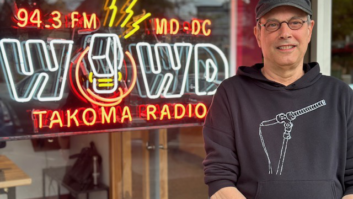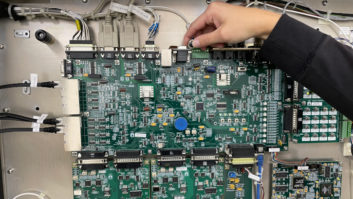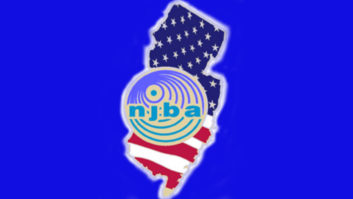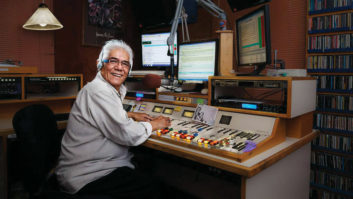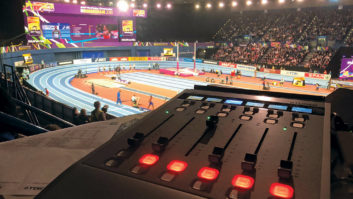A Love Affair With Radio
Regarding your recent article “For AM DXers, the Romance Lives On” (April 21):
I too was one of those early hobbyists who as a young boy became fascinated by the “theater of the mind” created when listening to distant fading signals in front of my grandmother’s floor model Philco.
Was WLS in a big tall skyscraper? Were there producers, directors, musicians, singers all gathered in a huge studio around the studio microphone waiting to sing “Double You El Ess” on cue from the tuxedoed man with the baton? Was Dick Biondi really fired for playing too many Elvis Presley records? I had to know.
Fifty years ago this month, I began my own journey into broadcasting. After being fascinated by the business for years, in the summer of 1960, I was hired at WNIA in Cheektowaga, N.Y. for 90 cents an hour to become “Mac McGuire — The Live Wire.” (I lied about my age; I was 14).
It’s been a journey I have never regretted. I’ve met rock stars (I interviewed John Lennon) and I have met three presidents, all because of radio. When the clock radio clicks on in the morning I still can’t wait to get to work. I think there is a reason that New York, the No. 1 city in America, is called “Radio City,” and that the No. 2 city is called “Television City.”
I was particularly moved by the 1961 “QSL” letter you printed (June 16, page 4) from Joseph H. Rohrer, owner, president, manager, chief engineer, announcer and “janitor” of WLCX, concerning the distant reception in New Zealand of his 250 watt, 1490 AM station in La Crosse, Wis.
The letter appeared to be written on a well-worn manual typewriter (complete with a few typos). I imagine Mr. Rohrer to be a very special man who embraced the passion, drive and enthusiasm for his very local radio station in this small Wisconsin city bordering the Mississippi River that once prided itself on making great beer.
He also appeared to possess that magical “care quotient” that drove a busy man to write a lengthy letter of appreciation to a man a distant continent away.
Radio is one of the last of the great apprenticeships. It is our duty to take what we have learned, and pass it on. Although Mr. Rohrer is a “silent key” and the stations have passed through several owners, it appears that his successors have kept the flame alive.
WLCX is now WLFN and is part of a four-station, locally and family-owned cluster. On a trip several years ago, while visiting family in Wisconsin, I knocked on the door of the radio station building and was greeted by Ed and Sally Sullivan, who were broadcasting live at the time.
Since 1988, the Sullivans have done a live show on WLFN called the “Blarney Party.” After introductions were complete, Ed and Sally invited me to join them behind the microphone for what became one of my most enjoyable broadcasting memories in years. It was clear that the Sullivans were very comfortable behind the mike, with their local show featuring great music, fun, humor and public service.
Radio was doing what it has always done best: connecting people in the “interest, convenience and necessity” of the public (Communications Act of 1934).
It’s easy to fall in love with this business. Like all love affairs, it must be nurtured to grow.
To a broadcaster that means: Always tell the truth; be there for your partner (listener/clients); be loyal; radiate positive feelings; don’t say things you will regret; and learn to communicate. (Oh, and don’t let there be silence). The “caretakers” of the WLCX legacy seem to have learned that lesson well.
Paul, thanks to Radio World for helping us rekindle the flame that is radio. PS: Just last week, I sent out a QSL letter to a Michigan DXer who heard one of our Florida stations.
Jim Davis
Vice President/General Manager
Vero Beach Broadcasters
Vero Beach, Fla.
Take a Moment
I enjoyed the article on AM DXing immensely.
As a broadcast engineer, I also have a lot of nighttime travelling and do both AM and FM band DXing. It’s fun to catch the distant FM stations as well. Fog, atmospherics or tropospheric bending can make this very interesting.
Only a few summers ago, I listened solidly to an FM from Connecticut for 20 minutes while driving down the road here in the Upper Peninsula of Michigan. A small, narrow, fast-moving band of severe thunderstorms were credited for that catch. I also turned on my 2 meter ham rig when this was found and listened to repeaters from Pennsylvania.
The only disappointment was the FM broadcast station not acknowledging my e-mail with a simple response.
Like many in my age group with a love of radio, I grew up listening to the AM clear channels and their quality programming.
Sadly, manmade noise, AM IBOC and the lack of selectivity and sensitivity in today’s radios make AM listening at any time of the day a challenge. Often, when a listener to one of my group’s two AMs complains of signal reception or noise, I find it’s the poor-quality radio they have in their vehicle or at home.
The next time one of those crazy Swedes or Finns sends you a QSL request from the ice plains, take a moment to respond. As busy as I am, I always give them an acknowledgement. It does bother me a little though that they often list receiving equipment valued at more than the car I drive!
Allan A. Augustyn
Director of Network Engineering
Radio Results Network
Escanaba, Mich.
Great Listening
In the 40+ years that I’ve been in the radio business, I think it safe to say I’ve answered about a thousand reception reports from various stations I’ve worked at or did contract engineering for.
My listening started back in the early ’60s, when Monday mornings were the prime time to DX. I remember getting up at a.m. to start listening on a Hudson car radio (later moving up to a Hammerlund HQ180), sitting in the bedroom when I lived just outside of Philadelphia near Chester and listening to frequencies such as 1460 and 1370 being completely clear of any signals — nothing!
You might get lucky and hear a station running an equipment test, and hear that it was in California or Washington state. There were mornings when WKBW would be off at 3 a.m. and you could listen to Radio Caroline sign on at 3 a.m. clear as a bell.
I also ran many “DX tests” from stations, making the state of Delaware a very easy catch for many people. I’m still trying to figure out who has the most verifications I’ve signed from the various stations for which I did the tests.
It’s gone full circle, I’ve come back to many of the stations I heard 25 years earlier to do engineering service, and say to myself, “How did I ever hear this?”
I still tune over the AM dial from time to time, keeping my Stewart-Warner R390A operational; things have changed so much with the granting of the low power at night for the daytime stations; no one signs off anymore, and now the horrible interference from HD.
But it’s still interesting and amazing with what you can hear and read about in the various DX and radio publications. I’ve been a member of the National Radio Club since 1964 and held many editor positions with them since the mid-’70s.
AM radio will always be a great source for listening, near and far!
Dave Schmidt
New Freedom, Pa.
Listening for ’FUN
I enjoyed the article regarding AM DXing and the followup letters in the June 16 issue.
We used to receive numerous letters from DXers from Scandinavia but also throughout Canada, especially in the north.
At that time CJVR was on 1420 kHz (10,000 watts) with half-wave towers so the sky wave was pretty good, especially during the winter. We also had reports from Vancouver Island, where our signal would come down in the skip zone (the area where the ground wave disappeared but for the sky wave came down) for Vancouver’s CFUN on 1410 kHz. When we signed off at midnight, CFUN in return would be strong enough to be picked up by our off-air monitor and played through the station.
On a different note but in the same vein, in the summer of 2008 we had reception reports of our FM stations via sporadic E layer skip in Ohio and western New York. The reception report letter also included a screenshot of our RBDS data from the DXer’s RBDS monitor, and an MP3 audio clip. You can’t get more serious than that in a hobby!
Thanks for the great magazine and keep up the good work.
Bayne Opseth
Chief Engineer
Fabmar Communications
CJVR(FM)/CKJH(AM) Melfort, Saskatchewan
CIXM(FM), Whitecourt, Alberta
CHWK(FM), Chilliwack, British Columbia
Audimax & Volumax
Regarding “Audimax Memories” in the April 21 issue Reader’s Forum section:
Radio World has in its 1970s archives an article I wrote about improvements to these venerable units.
Besides improving the upper end, a bit dubious considering the lack of info above 14 kHz, and the necessary roll-off for the stereo signal, the low end could be improved significantly with high-value coupling caps and better power supply filtering (I used a 2N3055 as the pass transistor clamped with a zener diode) got noise to –80 dB or better.
Likewise I caught heat for suggesting a larger filter cap for the Belar monitor that got the AM hum down. The A/V combo after mod would give the Optimod stations fits.
Henry Ruhwiedel
aka “Radio Doctor”
Chicago
Ed. Note: When we contacted the author for permission to publish the above letter, he described himself as an “older than dirt engineer.” He then sent the following postscript, which we felt compelled to include:
“There’s several of us here who are older than dirt. We recall rubbing two stones together to make dirt for our coherer detectors and clay leyden jar condensors, and using lemons and olive oil to make batteries with palm reeds and gold/silver/tin foil. Some of these were found in ancient Egypt, but our initials had already worn off.
“With enough clay batteries we could make simple sparks and, using carbon rods made from charcoal compressed into bamboo stems, a simple arc lamp for night work. It was a smaller carbon footprint than burning wood and closer to the correct color temperature.
“This led to the arc modulator, where we were able to use a papyrus cone to concentrate the sound of our voices into the arc path. Winding a coil around the outside of the condensor pots, with an attachment to a long wire a few turns above Earth, allowed the arc to oscillate and create long-distance magnetism that was then detected on the other side of the palace, with the coherer and battery set to provide the Pharaoh with music in any room of the palace.
“Because of the heat created in the arc, this became known as a hot air emitter. The odor of the burning of the reed holding the carbon rod was likened to that of bull dung.”
Radio World has our history experts checking into the veracity of this account.
Time to Go Snorkeling
Please do a followup to your excellent article “Are More Stations Going Silent” by Randy Stine, published in March 2009. As far as Hawaii AM goes, two of the three listed as silent were back on the air as of May 1 of this year.
I worked for American Broadcasting Co. from 1963 to 1990 in California (O&O AM/FMs) and in 1990 received the first “buyout” as management was interested in going “non-union.” This was great for me because California had lost its appeal to me, with massive illegal immigration supported by mayors/police chiefs and horrible taxes.
So by 1996 I had a license for a 1 kW AM in Maui. It took four years to get the tower/ground system installed. I also sprang for a new Nautel 1 kW to take the load off the Collins 20V2 I shipped from California, along with lots of “working obsolete” equipment.
The FCC’s new rules that allow them to set a minimum bid price for an almost worthless AM frequency have made it easy for millionaires/large group owners, along with tax-exempt religious groups and public radio, to control everything.
The old system was better. You could apply for a frequency and, if nobody objected, you just paid for the real estate, equipment, lawyers, engineers — and staff — not some unrealistic FCC minimum bid (assuming they ever open an AM window to apply). Plus, in this economy? Selling AM radio spots to starving small business owners? Good luck! Social Security and welfare make more sense.
Time to go snorkeling!
Richard Miller
Maui, Hawaii

Oops! Davicom Correction
A product report system in the June 16 issue (page 18) titled “Davicom Adds Features to MACs” was accompanied by the wrong photo. Shown here is the correct product image.
Also, the current version of MacNet multisite alarm management software is Version 5.40. The e-mail address for more information is [email protected], and the company website is www.davicom.com.





